Amplifying human potential
How is the cloud disrupting the workforce? Is creativity the new superpower? These were key themes debated at the recent Bett Show, the UK’s largest education and technology event.

Click on the cover to access the digital edition, read all of the articles on our website, or order your printed copy.
As the world becomes increasingly connected, artificial intelligence (AI), machine learning and cloud computing have become indispensable tools and understanding the tech that enables applications is fast becoming fundamental to every industry.Cloud and distributed computing skills have been rated as the most sought-after ‘hard skill’ by employers for the past four years in a row, according to LinkedIn. Only being topped in 2020 by Blockchain and surpassing analytical reasoning and AI. As demand for cloud skills rises, so does the need for global business communities to build effective pipelines that drive economic growth and opportunity.
What are cloud skills?
With an inherent belief that the future of work is the cloud, Amazon Web Services (AWS) is working with organisations to develop workforce strategies that bring together stakeholders from multiple sectors to build pathways into cloud jobs across entire regions, states and countries.“We are in the midst of a fourth industrial revolution that is driven by the cloud and advanced services such as IoT [the Internet of Things], robotics, AI and machine learning, and it is changing the means of production and disrupting the workforce,” explains AWS worldwide education director, Ken Eisner.“When we look at cloud computing we define these job opportunities into four different families. The first is software development – from DevOps engineering to mobile app development and so on. The second is cloud architecture; third is the whole data world, from AI to analytics and machine learning; and lastly is the operations field, including cloud support to cybersecurity. AWS Educate was created to address this [skills gap].”A new way of learning
But the cloud and all its associated disruption don’t simply require IT skills, notes Mr Eisner. “The future of learning needs to be hands-on to meet this trend. We need more people with practical and real-world skills. It is not about making more consumers – we need to make our students creators.” “The future of learning relies on new competencies from a communication perspective, not just passive ones. We need to learn to tackle problems and deal with ambiguity. How to invent and simplify, encouraging invention along the way. Do we really reward people enough for taking risks? We have to encourage our students and employees to really think big.”
“The future of learning relies on new competencies from a communication perspective, not just passive ones. We need to learn to tackle problems and deal with ambiguity. How to invent and simplify, encouraging invention along the way. Do we really reward people enough for taking risks? We have to encourage our students and employees to really think big.”Lifelong learning will be the trend of the future
Learning also has to be lifelong, adds Mr Eisner. “Everybody says this, but it has to be more than lip service. We have to embed that curiosity. Education, as a result, has to become more modular. We need to also think about how we deliver a modular education and work with an adaptable pedagogy. We are not workers and we are not students – we are always learners and collaboration between industry and education is going to be more and more important in the future.”Related articles:
- The future of skills: being human
- Creating a high-performance, humane workforce for the future
- Global Mobility in the age of AI
Hybrid intelligence
This year’s Bett Show – which brings together education, technology, people and ideas – was held in January at the ExCeL London. Microsoft gave a keynote speech on Hybrid Intelligences – Amplifying Human Potential and led with new research that examined what teachers would need in the classroom of 2030. Leila Toplic, emerging technologies initiative lead at NGO NetHope, explored technologies that are widening access and empowering educators, staff and students to accelerate their impact and transform the world.During the session, Microsoft explored how machines can work with humans as creative partners: with machines offering efficiency and fabrication, and humans a tactile craft process, muscle memory and invention to build solutions for pressing issues. “There has never been a better time to be a student or a teacher,” said Ms Toplic. “Technology is not a silver bullet, but it can be a powerful equaliser.”Ms Toplic discussed topics from medical advances in cancer treatment to water purification and how AI-enabled devices and chatbots are creating humanitarian and educational benefits. “[People] require more access to meaningful work and need to be inspired to lead change in communities and be active participants and creators, regardless of who and where they are.”An Arabic and English chatbot called Hakeem – a collaboration between NetHope, Microsoft and others – uses AI and cloud tools in rural regions to provide the right skills training, from language and entrepreneurship to coding.Yet there are just as many critics of cloud computing, AI and machine learning in education and the workplace as there are advocates. There is also concern that leading tech companies have a vested interest in reinforcing the value of advanced technologies. Microsoft argued that “technology should help us and amplify us”. Unlike the renowned computer scientist Mark Weiser who once said, “The most profound technologies are those that disappear. They weave themselves into the fabric of everyday life until they are indistinguishable from it.” What was universally agreed, however, was the value of creativity.Watch the Microsoft Education BETT 2020 Keynote: Hybrid Intelligences - Amplifying Human Potential
Nurturing creativity
Erik Hanson of Apple discussed the critical role of creativity in driving human progress and innovation. “For 40 years, Apple has worked alongside educators and has seen that creative expression leads to deeper engagement and productivity,” he said. During his talk, Mr Hanson explored how creativity is brought to life through Apple’s Everyone Can Create curriculum, which helps educators find and harness the creative genius in students at an early age.Following on with the future of work theme in his illuminating Beyond Tomorrow talk, the author of Learning Reimagined, Graham Brown-Martin, highlighted the value of creativity and warned against “ready-made knowledge”. Referencing a Seymour Papert quote, he added that the role of employers and educators is to ultimately create an environment where creativity and invention thrive.Creativity and work: How art can liberate thinking within organisations
In order for truly successful and impactful innovation, Mr Brown-Martin stressed the need for diversity. “Diversity is more important than consistency as a driver of innovation. You have to represent all types of people before you design and innovate to create a solution that is fit and representative of everyone and has the impact and potential needed,” he said.Quoting Alibaba founder Jack Ma at the Davos summit last year, Mr Brown- Martin said that we cannot teach people how to be smarter than machines, as we won’t win – instead, we must focus on our unique skills, “not stuff from 200 years ago or in 30 years we’ll be in trouble.”He also discussed the power of making and the importance of exploiting the areas where humans beat machines. “We need to automate the work and humanise the jobs,” he said. “I don’t think knowledge is power, it’s how we apply our knowledge – that combination is what works.”
For more information, visit our Education or Technology hubs.
Subscribe to Relocate Extra, our monthly newsletter, to get all the latest international assignments and global mobility news.Relocate’s new Global Mobility Toolkit provides free information, practical advice and support for HR, global mobility managers and global teams operating overseas. Access hundreds of global services and suppliers in our Online Directory
Access hundreds of global services and suppliers in our Online Directory
©2025 Re:locate magazine, published by Profile Locations, Spray Hill, Hastings Road, Lamberhurst, Kent TN3 8JB. All rights reserved. This publication (or any part thereof) may not be reproduced in any form without the prior written permission of Profile Locations. Profile Locations accepts no liability for the accuracy of the contents or any opinions expressed herein.







































